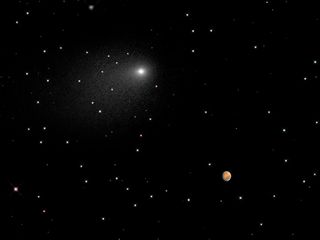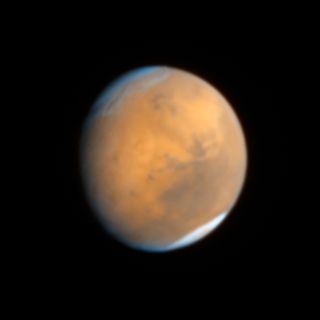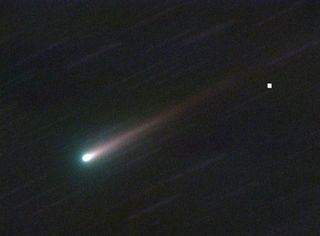Wow! This Hubble Telescope Photo of Mars with a Comet Is Amazing

The famed Hubble Space Telscope has captured a jaw-dropping view of a comet making an incredibly close flyby of Mars.
The space telescope snapped the amazing image when Comet Siding Spring (also called C/2013 A1) was hurtling through space near the Red Planet on Oct. 18 and Oct. 19. During its closest approach on Oct. 19, the comet passed about 86,000 miles (138,000 kilometers) from Mars — just one-third of the distance between Earth and the moon.
Mars and the comet shine in Hubble's new image. The planet glows red, and Comet Siding Spring's bright nucleus and diffuse tail stand out against a host of background stars glimmering behind the two cosmic bodies. The photo was created by combining separate images of the comet and Mars taken over the weekend. [See more amazing Comet Siding Spring images]

"The Mars and comet images have been added together to create a single picture to illustrate the angular separation, or distance, between the comet and Mars at closest approach," NASA officials said in a statement.
"The background starfield in this composite image is synthesized from ground-based telescope data provided by the Palomar Digital Sky Survey, which has been reprocessed to approximate Hubble’s resolution," space agency officials added. "The solid icy comet nucleus is too small to be resolved in the Hubble picture. The comet’s bright coma, a diffuse cloud of dust enshrouding the nucleus, and a dusty tail, are clearly visible."

Hubble officials couldn't capture both the comet and Mars in the same frame properly because the planet is about 10,000 times brighter than Siding Spring, according to NASA. The two cosmic bodies are also moving, and Hubble could only properly track one at a time.
If the space telescope took an image of both at the same time, at least one of the celestial targets would have been blurry, NASA officials added.
Get the Space.com Newsletter
Breaking space news, the latest updates on rocket launches, skywatching events and more!
Other NASA spacecraft also caught sight of the historic flyby. The space agency's Mars Reconnaissance Orbiter and Opportunity rover both captured images of the comet passing by Mars. NASA's Mars Atmosphere and Volatile EvolutioN (MAVEN) and Odyssey probes were also expected to observe the comet's close pass. The space agency's Curiosity rover was also in position to study the comet.
India's Mangalyaan orbiter circling Mars and Europe's Mars Express spacecraft were also expected to observe Siding Spring's flyby.
Follow Miriam Kramer @mirikramer and Google+. Follow us @Spacedotcom, Facebook and Google+. Original article on Space.com.

Join our Space Forums to keep talking space on the latest missions, night sky and more! And if you have a news tip, correction or comment, let us know at: community@space.com.

Miriam Kramer joined Space.com as a Staff Writer in December 2012. Since then, she has floated in weightlessness on a zero-gravity flight, felt the pull of 4-Gs in a trainer aircraft and watched rockets soar into space from Florida and Virginia. She also served as Space.com's lead space entertainment reporter, and enjoys all aspects of space news, astronomy and commercial spaceflight. Miriam has also presented space stories during live interviews with Fox News and other TV and radio outlets. She originally hails from Knoxville, Tennessee where she and her family would take trips to dark spots on the outskirts of town to watch meteor showers every year. She loves to travel and one day hopes to see the northern lights in person. Miriam is currently a space reporter with Axios, writing the Axios Space newsletter. You can follow Miriam on Twitter.
